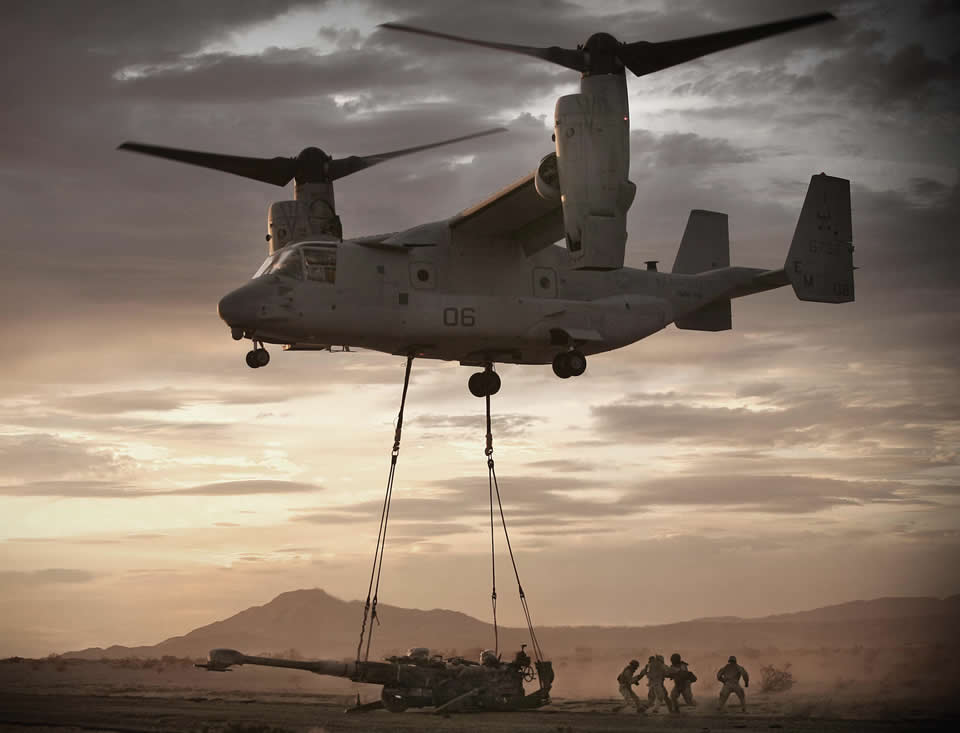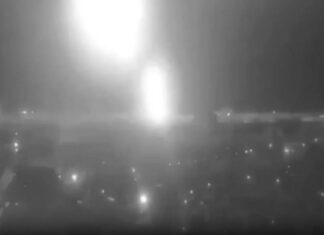What looked like a sea of red engulfed Ginowan City, Okinawa in the area surrounding Marine Corps Air Station (MCAS) Futenma on 9 September as a claimed 101,000 demonstrators rallied in protest of plans to deploy a squadron of Marine Corps MV-22B Ospreys to the Marine air station to replace the aging fleet of CH-46 Sea Knight helicopters currently assigned to the base.
Protesters called for Japanese Prime Minister Yoshihiko Noda and the United States to abandon their efforts to begin operational flights of the Osprey in Okinawa in support of Marine Corps ground combat forces. The Marine Corps is in the process of replacing the Vietnam War-era CH-46 Sea Knights worldwide with the tiltrotor MV-22Bs as part of an overall effort to modernize and maximize the Marine Corps’ combat effectiveness with a focus on improving ship-to-shore capabilities in amphibious warfare operations.
Sunday’s demonstration was one of the largest anti-American protests to be organized in recent memory as organizers loudly exhorted attendees to reject the Noda government’s claims that the Osprey is a mechanically-safe aircraft and critical to the future defense of Japan. Okinawan news sources put the figure of demonstrators in the range of tens of thousands, but protest organizers claim a total of 101,000 participated.
Meticulous accident investigations conducted by the United States cleared the MV-22B and CV-22 aircraft of mechanical failure in two highly-publicized accidents; one in April in Morocco, and one in Florida in June. Japanese investigators reviewed the accident reports and concurred with the findings that determined both mishaps were the result of pilot error and not mechanical failure or design flaws.
The United States has agreed to delay operational flights of the Ospreys until the Japanese government makes public its independent review of the mishap reports conducted by a team of Japanese investigators. So far, Japanese officials have not released their report and the first contingent of Ospreys remains grounded at MCAS Iwakuni in Yamaguchi Prefecture on the main island of Honshu where they were offloaded last month to undergo final assembly and safety checks before being flown to Okinawa.
The emergency landing of an MV-22B in a residential area in North Carolina on 7 September near MCAS New River added ammunition to the rhetoric of the protest speakers in Okinawa. Preliminary information indicates that the MV-22B in North Carolina made a controlled landing as a result of an oil leak. Protestors in Okinawa claimed this incident was further proof that the Ospreys are structurally unsafe and present a real danger to Japanese residents in Okinawa and elsewhere.
On the same day, rallies were also organized on two smaller islands in the Okinawa Archipelago and an estimated 10,000 people surrounded the Japanese legislature (Diet) in Tokyo carrying protest placards and chanting anti-Osprey slogans.
Japan and the United States have been embroiled in a decades-long round of unsuccessful negotiations intended to find a suitable location to relocate the air station facilities at Futenma. Unrelenting Okinawan demands calling for a reduction in the size of the US military presence in the islands have effectively halted almost all progress in these negotiations and no one expects a resolution to be forthcoming any time soon.
While these mass demonstrations are a concern, not all Japanese residents are opposed to the deployment of the Ospreys. On the Japanese island of Ishigaki, located some 140 miles east of Taiwan and 265 miles south of Okinawa, the residents are thrilled to have the Ospreys in the neighborhood. The Ishigaki Island government is responsible for exercising jurisdiction over the fiercely-disputed Senkaku Islands, a collection of hardscrabble rocks claimed by Japan, China, and Taiwan.
Ishigaki residents share a unanimous belief that the Ospreys are critical to safeguarding their homes and the Senkaku Islands. Ishigaki resident Eizo Tomoyose is quoted as saying he had no doubts “that the deployment of the Ospreys to Okinawa will enhance the defense and deterrence power in the event of an emergency situation in the Senkakus.”
An Ishigaki citizens group, of which Tomoyose is a member, sent petitions to Okinawan Governor Hirokazu Nakaima and the mayor of Ginowan City pleading with them to drop their opposition to the deployment of the Ospreys. The group sent a similar petition to the mayor and city council in Iwakuni as well.
Ishigaki Island residents feel that the people in Okinawa, and their government representatives, lack an awareness of the potential dangers the people of Ishigaki face with China’s insistence on claiming territorial rights to the Senkaku Islands. The islanders also feel that their countrymen in most other parts of Japan are not concerned with and care little about the safety of the Ishigaki Islands.
Another Ishigaki resident, Magonori Ohama, said that Okinawans “have little interest or concern about the situation surrounding the Senkakus today.” He went on to say that deployment of the Ospreys “gives a great sense of security to us, especially those who live in the border town.”
Of course, the Ishigaki resident’s pro-Osprey viewpoint is in the minority. A public poll compiled by the Kyodo News Service in early September found that almost 70 percent of the Japanese surveyed harbored a negative opinion of the Ospreys and yet, nearly the same number of respondents expressed the view that US forces stationed in Japan are a critical element in protecting Japan’s national security and political stability and are necessary.
Since the formal end of the allied occupation of Japan and the return of Okinawa to the central government in 1972, American military and political leaders have been sensitive to Japanese concerns and complaints. The Osprey issue is just another example of how the United States continues to assuage local concerns while still maintaining an effective and properly-equipped military force of deterrence in defense of the Japanese islands and in support of the long-term maintenance of stability in the Asia-Pacific region.
Unfortunately, reality is sometimes a difficult concept for some Japanese to accept. The reality is that the MV-22B is the only vertical-launch; medium-lift transport aircraft the Marine Corps has available to replace the aging CH-46 helicopters. The Sea Knight helicopters have served well, but the airframe is well past its retirement age.
Without the Osprey, the Marines cannot perform their mission. If the Marines are unable to perform their mission from Okinawa or other locations in Japan, it is impractical for them to remain in Japan. The Osprey is the future of medium-lift Marine Corps aviation and that fact cannot be changed. There is no alternative airframe available and the United States is unable, from a practical standpoint, to satisfy the demands of the Okinawan protestors.




















